Innovation, creativity and initiative are the force of life for continued growth and survival of companies, and are of course at the base of entrepreneurs excited to begin a new venture. But is success guaranteed?
Often excitement is so overwhelming that companied start developing a new business without first examining risks and chance of success. Sometimes, we look at a business close to ours, competitors are profiting in it, and we decided to enter it and join the big players. We jump into the water, and discover too late we jumped into a red ocean.
We entered an over saturated market, with many competitors, and chances of success for a small new company is very low, unless they bring with them innovation and a pronounced advantage.
Until a few years the solution was an extensive business plan including risk- and rewards-assessment as well as a future profit and loss report.
But, as anyone who's ever made such a plan knows it's susceptible to wishful thinking. As much as we try to be objective – included data will be influenced by our initial position. At times, it's enough to include an extra percent or two in the growth plan or under-estimate expanses, for the result to change from loss to profit.
And so companies or entrepreneurs invest time and money and develop a new unneeded product , or one that can't compete with existing products, or for which expanses are higher than estimated.
Despite the above disadvantages, the business-plan model hasn't lost its relevance, and there are tools to handle predicted changes in the market place (as I will discuss below). At the same time, over the last few years a new model has superseded the business-plan – Lean Canvas. Although it doesn't replace the business-plan completely, it has become the model for Go-No-Go decisions, stop or continue.
Lean Canvas
The Business Model Canvas was developed by Alexander Osterwalder in 2010, as part of his dissertation.
The main advantage of this model comes from the requirement for very clear-cut answers. If you doubt your answers - reconsider your idea. Working with this model is short, simple, and clear.
Along the process of new development, too, it's a good idea to re-examine your answers, at every stage and every few months.
Let's look at the below diagram and discuss its stages:
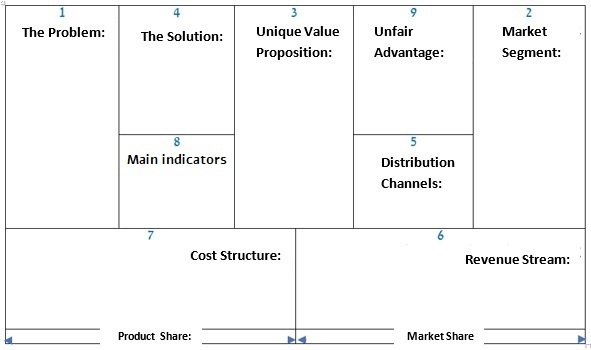
Filling out the above board is done by the number of the stage.
- The problem. Some entrepreneurs think up a great (in their opinion) new idea, and start advancing a startup to develop it. But is it needed? Are there clients who will pay for the product or offered service? The first question to be answered, then, is what is the problem, not what's the solution. What's the problem the product or service address. If there's no problem, don’t create a solution.
- Market segment. What is our product's target market? A few years ago, I talked with a young entrepreneur who was very excited by a service that was popular in the center of Israel, but didn't exist in the periphery.
That same entrepreneur's wife was worried their money will be lost in a big investment, and convinced him to meet with me. When we reached the market segment stage, he gave a detail description of the many providers in the center of Israel and their popularity. He expounded on the number of inhabitants in Beit-She'an and Kiryat Shmona, where not one provider existed. The field awaits, untouched, with no competition. I asked him how far a costumer in the center of Israel had to travel to receive the service, compared to the distance a costumer in Beit-She'an or Ramat HaGolan will have to travel.
The answer didn't need to be said out loud. The conclusion was clear: there was no place for such a service in sparsely populated areas. - Unique value proposition. If we don't have one, why will anyone purchase our product or service? Why should we invest time and money only to see a year later the project isn't progressing, money disappears as if into a black-hole, and no profit can be expected. And then, after significant investment, instead of halting the project, we decide to give it one more chance, and the project keeps sucking up money.
This question is, to my mind, the key. It's one of the more important stages of the nine. - The solution. Only now do we turn to the solution, your new idea. You should present your idea in a clear and detailed way. If you leave any unclear parts – does it mean you don’t know how you'll complete the product? If that's the case, you should answer that lacuna before beginning work.
- Distribution channels. How do you plan to distribute your product or service?
- Revenue stream. Here I recommend, as I always say and write in this context, to work with a yearly-plan. Start with planned revenue in 3 to 5 years and move back until the current year. This year's plan breakdown to monthly action plans. This plan is both an execution and monitoring tool.
- Cost structure. Can you predict future costs? If so, excellent, write them down, and once you begin development and production – keep track of them. See that you're following your plan. If you're unable to predict costs, don’t begin production.
- Main indicators. This stage, too, is an important one. I still meet many managers who would rather work without indicators. As if, if they don't monitor themselves or their employees, no problems will arise. The truth in the opposite, indicators are essential in order to guarantee desired progress. That we're moving towards our goal, and not in a different direction. Would you drive in car without a gas-meter, or a speedometer?
Don’t start working without set indicators. - Unfair advantage. What advantage will keep you ahead of competition? Let's say your idea is great. Can a stronger competitor copy your idea once you hit production? If so, you might not be able to recoup your investment. Before you start, examine what unfair advantage you have, or can produce. And advantage which will guarantee you're always ahead of competitors. A patent is such an advantage, but there are others. It's not always possible or advisable to get a patent. There are other advantages. For example, the ability to always keep ahead of the market. Always develop the next generation of your product or service.
Three Groups of Stages
I divide these stages into three groups:
- Go-No-Go. Stages 1, 3, and 9 are such stages. Don't start if there's no problem your solving. Don’t start if you don’t have a unique value proposition – something you can offer that others can't. Don’t start if you can't guarantee an advantage preventing others from copying you and profiting instead of you.
- Plan and monitoring. This category includes stages 6, 7, and 8.
- Stages 2, 4, and 5. These are important stages, but once you filled them out you can advance. They don't require continued monitoring, only once in awhile.
Business-Plan Sensitivity-Board
I mentioned above that the classic model of the business-plan hasn’t disappeared. It's still necessary. In order to avoid biases and mistakes, I tend to build the numerical plan, the profit and loss report, in excel, so that all the numbers are linked, and you can, with one press of an excel cell, rise or decrease sales, or in the next cell, increase costs.
For the next stage, once the plan shows a good profit and a reasonable cash flow, I start to increase costs and decrease expected sales. The results, I list in a chart. When the result is a loss, it's listed in a red cell. When it's a profit, in an uncolored cell.
See below a sensitivity chart I once built for an entrepreneur. Notice the situations which lead to a loss.
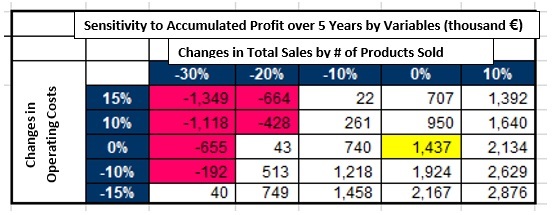
Below see an additional sensitivity chart I prepared for a different client. This plan is stronger and more resilient in the face of changes.
These sensitivity chart show accumulated profits over the first five years. I tend to build a similar sensitivity board for the first year, and according to cash flow.
The client whose sensitivity chart below showed resilience for accumulated profit over the first five years, ended up not investing due to problems with cash flow.
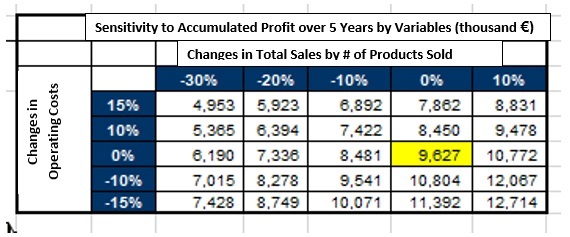
Since we tend to include data according to our initial bias – the sensitivity chart better shows risks. The more red cells you have, the more your plan is vulnerable to future changes, and you should carefully consider whether or not to embark on it.
Summary
The Lean Canvas Model has become a necessary first step before starting any new business or product development.
I showed above how to work with it and which stages are Go-No-Go.
Additionally, I showed how to continue working with the traditional business plan model.
The final result in a loss and profit report only has meaning when we include changes in sales numbers and costs, and examine the profit's sensitivity to those changes.
If you're interested in my help in building a Lean Canvas Model or business plan, and in thinking about business strategies (for yourself or your company), you can contact me through my website (here).





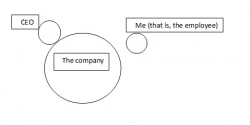




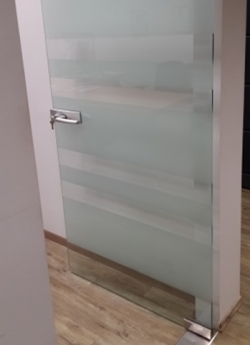

 My First Book: Manage! Best Value Practices for Effective Management
My First Book: Manage! Best Value Practices for Effective Management